Electrons and Photons and Black Holes, oh my!
The universe is a simple place. It is filled with a large number of clones of a very small number of entities that interact in a limited number of ways as defined by Feynman. No free will, no exceptions. It is all so very elementary, my dear Watson.
The universe is, we think, describable as having a four dimensional geometry we have named "TimeSpace". I say "we think" because we have evolved over the past several millennia interior to this universe, hence, we lack the perspective (literally) to assess the true nature of our situation. Edwin Abbott Abbott's Flatland: A Romance of Many Dimensions is a satirical (sociologically speaking) novella that describes this dilemma well. This book is online at Project Gutenberg.
The universe is incomprehensible if we try to understand it by trying to track all the constituent parts interacting in real time. That is an impossible task · · · literally.
While Reality (as I like to call it) is fundamentally unknowable, it is eminently understandable. If we focus our attention on only a few elementary particles interacting via a subset of the rules we can start to develop an understanding of the whole. For this discussion, let's consider one lepton, one boson, and one Feynman diagram as representative of Reality as a whole and use these to understand certain attributes of, TimeSpace and Black Holes.
For the leptons let's use electrons. Electrons are represented by the symbol in the lower left of the "Leptons" box of Table 1. For the bosons let's use photons. Photons are represented by the symbol in the upper left of the lowest "Particles" box of Table 1. These two particles plus an appropriate Feynman Diagram are what is needed to construct a viable toy model for the task at hand.
This display of Elementary Particles is from My side won the bet . . .
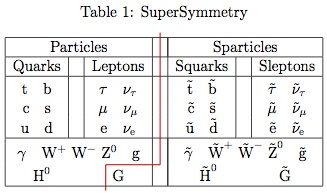
This display of Feynman Diagrams is from Wikipedia, the free encyclopedia.
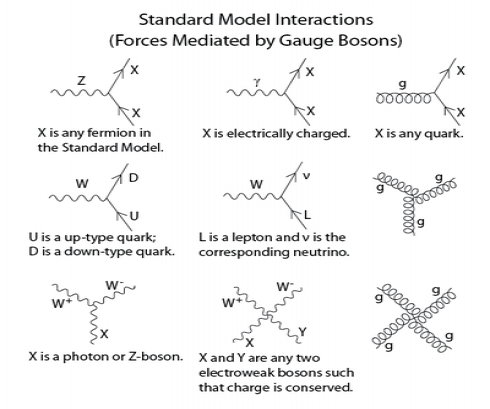
- The Challenge
-
- Using a toy model consisting of electrons, and photons as projectiles develop an understanding of TimeSpace far from and near massive objects.
- Given the two particles in this toy model the only primitive vertex needed to describe particle interactions is the first row's center diagram in the above display.
- The Caveat
- If we try to describe an event using only a single primitive vertex we encounter a fundamental contradiction:
Whether from, or toward, the net flow of Energy and the net flow of Momentum at each vertex must be zero. What goes in must come out, no exceptions! Each particle's Mass, Energy, Momentum, and Velocity are related thusly:
Lines with arrows represent electrons (mass = 0.511 MeV), wavy lines represent photons (mass = 0.000 MeV). If we try to use only one primitive vertex to represent an event like an electron absorbing (or emitting) a photon at least one of those arrows or wavy lines will have values of Energy and Momentum that correspond to a mass not characteristic of the electron or photon. We are forced to infer:
A single primitive vertex cannot represent an "Event".
The above four dimensional EnergyMomentum (aka MomEnergy, as a blend of Momentum and Energy) relationship has a homologous relationship in Minkowski diagrams of TimeSpace.
| EnergyMomentum | TimeSpace | |
|---|---|---|
| Invariant Mass | Is Like | Invariant Interval |
| Energy Scalar | Is Like | Time Scalar |
| Momentum Vector | Is Like | Position Vector |
Some find the geometry of TimeSpace easier to grasp than the geometry of MomEnergy, so if you will · · ·
We use Minkowski diagrams to track events of interest. We can, for example, use the interval between two events to characterizes some aspects of particles.
For example, creation and annihilation events, for a photon, are separated by an interval of zero extent. This indicates: Photons only move at the speed of light,
A Critical Conundrum : At each vertex to which a photon is connected that photon is either being created or annihilated. Photons do not "experience" multiple, or sequential interactions, they are created, travel via an interval of zero extent, and then are annihilated. Could it be that between creation and annihilation, during that "interval of zero extent", nothing happens to the photon? I think the answer is, "Yes!" Sigh ! ?, such a meaningless "existence". Ah Ha! On the other hand, nothing of any interest could happen in the universe. If not for these massless messengers, we would not exist.
An electron, on the other hand, experiences an uncountable succession of interactions. Any two successive events are separated by an interval in which the time part is greater (usually much greater) than the space part. Stated another way: The square of the interval is a positive quantity. Or, in other words, the interval is a real quantity (as opposed to an imaginary quantity). These time-like separated events indicate: Electrons only move at speeds less than that of light,
Any given interval is a Lorentz scalar, all observers discern the same value even as the time parts and space parts are very different. When "viewed" mathematically a complete set of observations describes a three dimensional hyperbolic manifold embedded in the four dimensional geometry of TimeSpace. Objects with mass experience time-like separated events, while massless objects experience light-like separated events. Space-like separated events have no causal relationship to each other.
Minkowski diagrams are usually drawn with the Time axis vertical. Because of this I prefer the "Time Flows Up" convention when constructing Feynman diagrams. I also prefer to use commensurate scales wherein 10 nanoseconds is represented by a vertical line segment approximately the same length as a horizontal line segment representing 3 meters. These two preferences lead to representing light (photons) as traveling at a 45° angle relative to the vertical and entities with nonzero mass traveling with an angle somewhat less than 45° with respect to the vertical.
For a given mass: The above Mass, Energy, Momentum equation describes a three dimensional hyperbolic manifold embedded in a four dimensional energymomentum space, hence we use the term "mass shell". "Shell"‽, why the word "shell"? Think of a two dimensional surface embedded in a three dimensional space, an egg shell is a reasonable facsimile of same, hence, the word, "shell". Then, just bootstrap yourself up one more dimension and Ta Da, you see a three dimensional "surface" embedded in a four dimensional "space". A point not on that surface is said to not lie on the particle's mass shell.
Before describing how these particles reveal information about curved TimeSpace, particularly near black holes, lets examine "normal" interactions in "flat" TimeSpace far from sources of gravitation.
Consider two relatively straightforward events (see below) in which two electrons exchange momentum and energy. Each interaction requires at least two primitive vertices. The example on the left involves the exchange of a virtual photon (a photon that does not lie on its mass shell) between the two vertices. The example on the right involves the exchange of a virtual electron (an electron that does not lie on its mass shell) between the two vertices.
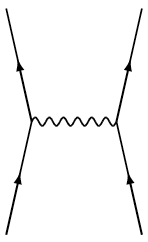
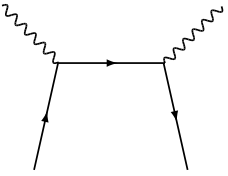
The left diagram describes the well known electron-electron repulsion. The right diagram shows an electron traveling backward in time, or more simply, a positively charged electron (aka positron) traveling forward in time as it interacts with an electron. This interaction annihilates both (negative and positive) electrons to generate two photons (aka gamma rays) in a process known as Pair Annihilation.
I emphasize the virtual (think "unreal") nature of the exchange particles by drawing them far from any realistic world line. The vertices do not represent separated (in any sense of the word) events.
Rotating a diagram in part (as shown on the left), or as a whole (as shown on the right) allows us to describe additional types of events: On the left an electron collides elastically with a positron. On the right an electron-positron pair are created as two photons collide, in a process known as Pair Production.
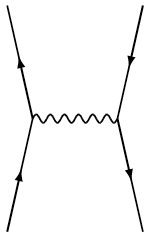
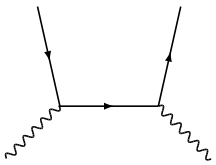
Rotating the left part of Pair Production diagram reveals a diagram representing a photon bouncing off an electron in a phenomenon known as Compton Scattering.
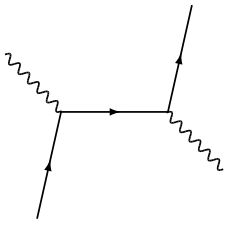
The usual scenario is for a photon to transfer part of its energy to the electron. The now lower energy photon moves off at an angle (the scattering angle) with respect to its initial direction of motion while the recoiling electron moves to maintain the conservation of momentum during the process.
- In all of the above diagrams an event occurs as:
-
- Real particles enter from out of frame through the lower boundary.
- Various processes via various vertices unfold in the middle of the frame.
- Real particles exit to out of frame at the upper boundary.
Now that we have our projectiles, the next step in understanding black holes is to consider a classical conundrum: An infinitesimal mass, An Electron, is moving in the vicinity of a large stationary mass, The Sun. Describe the trajectory of the infinitesimal mass.
An Electron is said to possess kinetic energy (a function of its velocity) as well as gravitational potential energy (a function of its position relative to the Sun's center). The Electron's total energy is given by:
For convenience let the Electron be moving perpendicular to a line the runs through its and the Sun's centers. If this be the situation there are some interesting trajectories depending upon the Electron's kinetic energy at this location.
and the Electron will have a trajectory that is a circle with the Sun at its center. This trajectory is said to have an eccentricity of zero.
and the Electron will have a trajectory that is a parabola with the Sun at its focus. This trajectory is said to have an eccentricity of one.
and the Electron will have a trajectory that is an ellipse with the Sun at one of its foci. This trajectory is said to have an eccentricity between zero and one.
and the Electron will have a trajectory that is an hyperbola with the Sun at one of its foci. This trajectory is said to have an eccentricity greater than one.
This graphic presentation attempts to highlight two features of positive eccentricity trajectories, the impact parameter, and the angle of deflection.
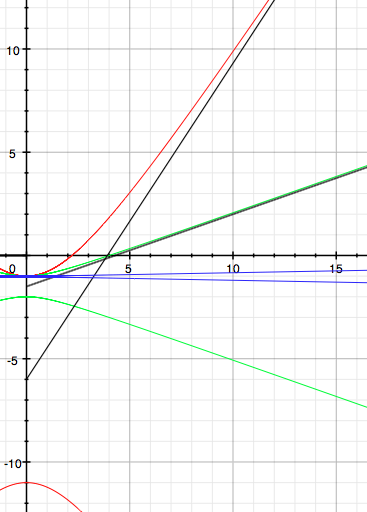
The large mass (The Sun's center) is at the origin of the coordinate system. The infinitesimal mass's (The Electron's) trajectory is represented by three colored hyperbolic curves.
The sloped black lines represent the asymptotes to the hyperbolic curves. I did not include the asymptote for the blue hyperbolic curve as it would have obscured that curve. The asymptotes represent the electron's trajectory if the gravitational interaction did not exist. The shortest distance between the asymptote to the origin is referred to as the "Impact Parameter". The angle of the asymptote with respect to the x-axis is the change in direction of motion as the electron travels from very far away to its point of closest approach as it crosses the y-axis. The electron's "deflection angle" is just twice this angle.
Impact Parameter
Deflection Angle
| Eccentricity | Impact Parameter | Deflection Angle |
|---|---|---|
| 1.20 (Red Curve) | 3.32 × Distance of Closest Approach | 113 ° |
| 3.00 (Green Curve) | 1.41 × Distance of Closest Approach | 38.9 ° |
| 55.0 (Blue Curve) | 1.02 × Distance of Closest Approach | 2.08 ° |
An electron traveling at greater than 0.21 percent the speed of light near the Sun's surface has enough energy to travel on a hyperbolic trajectory away from the sun.
Sun's radius = 6.957 × 108 meters.
Sun's mass = 1.989 × 1030 kilograms.
For speeds near this value the Electron's trajectory is on the verge of becoming parabolic. The slope of a parabolic curve has no upper bound, hence: As eccentricity approaches 1.00 the tiny mass's trajectory approaches parabolic, the impact parameter become arbitrarily large (we use the careless phrase "approaches infinity"), as the angle of deflection approaches 180°.
Finding the Size of a Black Hole : The Sun Example
-
- Energy of Projectile Approach
- Compress The Sun into a small volume. Solar system objects outside the Sun's normal radius will experience the same gravitational field as when the Sun was its normal size.
- Calculate the escape velocity of an Electron from various locations in the vicinity of The Sun.
-
- Distortion of Space Approach
- Compress The Sun into a small volume. Solar system objects outside the Sun's normal radius will experience the same gravitational field as when the Sun was its normal size.
- Calculate solutions to Einstein's gravitational field equations in the vicinity of The Sun.
Energy of Projectile Approach
This approach starts with the above orbital energy equation:
taken to the cosmic speed limit:
From closer to the center than the Schwarzschild Radius escape is impossible. From the Schwarzschild Radius escape is only possible for an object traveling at the speed of light.
Therefore, the Schwarzschild Radius is defined as: "the radius of a sphere such that, if all the mass of an object were to be compressed within that sphere, the escape velocity from the surface of the sphere would equal the speed of light."
Distortion of Space Approach
This approach starts with the observation: The solutions to Einstein's gravitational field equations in the vicinity of a non-rotating, spherically symmetric body contain the term:
This term has the unfortunate property of becoming arbitrarily large for a particular value of distance from the center of mass. That distance is referred to as the Schwarzschild radius.
This "going to infinity" condition is telling us that our mathematics (hence, our understanding) fails catastrophically at the Schwarzschild Radius. We have no understanding of what happens inside this radius, aka inside the black hole (aka "Here There Be Dragons"). Indeed the Energy Calculation starts to breakdown long before we get even close to the Schwarzschild Radius suggesting our confidence shades from high to extremely low over several orders of magnitude on the distance scale. The notion that the Schwarzschild Radius is determined by some object approaching the speed of light is naive at best.
So, while both approaches produce the same result for the Schwarzschild Radius the two approaches are fundamentally incompatible. The location of the "surface" of a black hole is not determined by where an escape velocity becomes the speed of light, it is determined by where our understanding (id est our theoretical models aka mathematics) fails.
Newtonian Gravitation is but an approximation that produces results just good enough for most processes of interest. I refer to the "Energy of Projectile Approach" as a bogus calculation because we know the calculation already starts to breakdown long before we get even close to the Schwarzschild radius: To illustrate this "just good enough" designation, consider the orbit of Mercury:
- Schwarzschild Radius for Sun
- Mercury's distance from Sun's Center
- Mercury's orbit is tens of millions of Schwarzschild Radii away from the Sun's center of mass.
- Mercury's Orbital Dynamics
- Anomalous advance of perihelion = 43 seconds of arc per century.
- Orbital Period = 88 days
- Perihelion Advance = 0.1036 arc-seconds per orbit.
- The Caveat
- If we try to describe an event using only a single primitive vertex we encounter a fundamental contradiction:
Whether from, or toward, the net flow of Energy and the net flow of Momentum at each vertex must be zero. What goes in must come out, no exceptions! Each particle's Mass, Energy, Momentum, and Velocity are related thusly:
Lines with arrows represent electrons (mass = 0.511 MeV), wavy lines represent photons (mass = 0.000 MeV). If we try to use only one primitive vertex to represent an event like an electron absorbing (or emitting) a photon at least one of those arrows or wavy lines will have values of Energy and Momentum that correspond to a mass not characteristic of the electron or photon. We are forced to infer:
A single primitive vertex cannot represent an "Event".
-
Mercury's orbit fails to follow a Newtonian orbit. Mercury's orbit is seven orders of magnitude larger than the Schwarzschild Radius. The properties of Mercury's orbit are intimately connected to the above energy equation. Obviously the above energy equation is inappropriate for this situation in this region of space. So the fact that this calculation produces a result of the correct order of magnitude is fortuitous and of little real consequence.
The surface of the black hole anomaly is not about what happens if you could travel at the speed of light. Sheesh!, everyone knows that if you travel at the speed of light while flying around the Earth, it slows to a stop, then reverses its rotation, so you can then rescue Lois Lane before she gets trapped in her car inside an earthquake induced fissure.
I am biased in the direction of saying: The gravitational process is not quantum mechanical and it will never be part of a fully unified theory of everything. This means: I think particles acquire the property of mass via a Higgs field interaction and gravitational interactions are the result of massive objects distorting an independently existing TimeSpace structure that may be a continuum. If TimeSpace proves to be quantized, then great consternation ensues as we try to understand our failure to detect gravitons, represented by the symbol (on the wrong side of the red boundary) in the lower right of the lowest "Particles" box of Table 1.
If my bias proves to be in accord with reality, then electrons and photons probe the TimeSpace metric in different ways and provide related, but not identical, information.
Inertial objects (non-zero Mass) distort TimeSpace as well as respond to distortions. The response is the shape of their trajectories wherein details (like eccentricity) are a function of their energy.
Massless objects do not distort (except possibly via the energy density of virtual processes) TimeSpace but respond to distortions created by Massive objects. The response of massless particles is independent of the particle's energy as described by Christian Magnan. Comparing the Deflection Of Photons to the Deflection Of Electrons highlights the differences. Again I use the Schwarzschild Radius as the appropriate scaling factor:
| Electron Trajectory | Photon Trajectory | |
|---|---|---|
| Impact Parameter | ||
| Deflection Angle |
A photon passing very close to the Sun's surface will be deflected a little more than 1.75 seconds of arc.
For an Electron to be so deflected it would be traveling along a hyperbola of eccentricity a little less than 13.5 million.
The photon would have approached the Sun with an impact parameter greater than the Sun's radius by a little more than 2 parts in a million.
The electron would have approached the sun with an impact parameter greater than the Sun's radius by a little less than 75 parts in a billion.
In the worked example both particles are deflected by the same angle as they pass by the Sun just touching its surface. The photon's approach path is separated from the Sun's Radius by a little less than 4 percent of the separation of the electron's approach path from the Sun's Radius.
I leave for the reader the following exercise: For a given impact parameter (your choice) calculate the deflection angles for each particle. Comment on how this result compares to the above result. This assignment is not optional and its results will form the foundation of a Course Final Examination essay question. Good Luck and may Doug have mercy on your Soul.
And now back to Feynman Diagrams
A perfect vacuum is not empty. I rather like this description by John Baez of the energy density of a vacuum. From a particle physicist's viewpoint, the vacuum state having a non-zero energy density means there is no place in the universe for which we can be certain there are no particles. Our jobs are secure!
A non-zero energy density implies Vacuum Fluctuations will occur everywhere and everywhen. These fluctuations involve photons that simply appear, travel for a short time / space, and then disappear. The (creation "event" followed by the annihilation "event") process is not detectable (at least not in any normal sense of the word) and the photons are said to be virtual.

Many invoke Heisenberg's Uncertainty Principle in one form or an other to "explain" this phenomenon. While this may be a good placebo for our wounded egos, I prefer to be honest rather than rationalize ignorance using pseudo logic. It happens, it's a part of how quantum mechanics behaves, get back to me when you have an explanation that actually explains this process.
Vacuum Polarization occurs as a photon briefly becomes an electron-positron pair. Like in the case for vacuum fluctuations I prefer to acknowledge my ignorance by stating this stochastic process is characteristic of quantum mechanical processes rather than invoke some silly pseudo explanation.
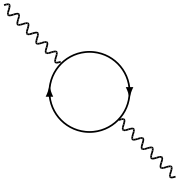
We know vacuum fluctuations, and polarization processes really occur, just as we know the top quark is a real thing. Our calculations require these processes to occur. If these processes do not occur, are not a part of Reality, then none of the events detected by our instruments my instruments actually happen, and we really are stuck in the Matrix.
In an announcement that is not without controversy Prof. Alfred Leitenstorfer at the University of Konstanz reported direct detection of vacuum fluctuations. I am not certain what I think about this announcement. I tend to be a bit skeptical, but that is my "flaw" and that's all I have to say about that.
Given the proper circumstances, Vacuum Fluctuations coupled to Vacuum Polarization could result in Vacuum Production. In a region where TimeSpace is sufficiently stressed these virtual processes could conceivably become real processes.
If one part of the virtual processes within a Feynman Diagram could be isolated from another part of the virtual processes, perhaps the corresponding bits could kick out what should be virtual particles as free moving real particles.
I, with my bias, reject the notion that interactions with gravitons might generate such a scenario. I suggest the most likely mechanism is a rapidly changing Stress-Energy Tensor within the region of large concentrations of mass. Two virtual particles in regions of different time rates would rapidly become decoupled, uncorrelated, and independent of one another.
If one or both of these (now real) particles were to travel away from the black hole's vicinity, energy and momentum would be carried away from the black hole. As a result the mass/energy of the black hole would diminish as it evaporates.
In other words: Maybe near the event horizon this comment is not true. Maybe in such extreme environs a single primitive vertex can represent an "Event"


Comments
(TLDR) Too Long, Didn't Read
For various reasons most readers will, at best, simply skim this article. This is not light reading, and it cannot be made into light reading.
This article exists because of an interesting conversation here. The truth is there is no shorter answer that I can produce. And, every time I try to shorten it in one place I find the need to expand it elsewhere to "take up the slack".
So, if this is of no interest to you, heed the standard warning: Your Mileage May Vary and as the traffic cop says, "Move along now, there is nothing to see here, it's not as bad as it looks."
No, it would not be easy for
an "ordinary" reader to understand.
Are you writing this in preparation for a book? If so do (really!) wish you the best.
One thing that should be clarified that events "on shell" correspond to "real" events and "off-shell" by definition involve virtual particles.
IOW, events that satisfy the Einstein E-p equation, E2 = P2 c2 - m2 c4 are "on shell" and those which do not are "off shell".
Mind you, the "shell" that the Einstein equation describes is (as you know) a hyperboloid of revolution in a 4-dim energy-momentum space.
"Off-shell" events correspond to internal propagators in a Feynman diagram. Of course, in the final "event", the reaction must again remain "on-shell", but in Feynman theory, all sorts of interactions involving virtual particles of undetermined masses and/or energies can in theory take place, in theory violating "conservation of energy", and therefore, being "off-shell" events, which is fine, as long the as long as the observed event remains on-shell.
I think that the concept of "virtual particles" of whatever mass you like (cf the J/psi of 1974, which was an exciting idea when I was at Oxford) within a diagram was an analogue of the Heisenberg uncertainty relation -- or the Schroedinger's cat paradox, that what ever takes place in the "black box" between observation "in" (cat in) and "out" (cat out, whether + or *) is intrinsically unknowable.
Therefore, to calculate the probability of an "event" requires the summation of an infinite series of increasingly complex Feynman diagrams with higher and higher off-shell terms, and thus of increasingly smaller amplitude.
The trick of doing event probabilities was [1] picking out, intuitively, the likeliest off-shell processes and [2] knowing when to stop!
Thx.
There are known knowns; there are things we know we know. We also know there are known unknowns; that is to say we know there are some things we do not know. But there are also unknown unknowns – the ones we don't know we don't know.
What did Schroedinger have against cats? n/t
There is no justice. There can be no peace.
Nothing. Everything. We won't know which until the box opens.
Everything I know about physics, I learned (gleefully) from Big Bang Theory. Thanks Chuck Lorre!
@HenryAWallace
And see whether the kitty litter within the box has been used?
Psychopathy is not a political position, whether labeled 'conservatism', 'centrism' or 'left'.
A tin labeled 'coffee' may be a can of worms or pathology identified by a lack of empathy/willingness to harm others to achieve personal desires.
I buried the lead ?
Thanks for the feedback. It seems in my emphasis on brevity I buried the "on shell / off shell" references too much. How, I am thinking a graphical representation might be useful for highlighting same. In part I am using caucus99percent as a test-bed for the Beamer Presentations I am building.
This is part of a series I started a few months ago when a colleague presented "Black Hole Everywhere" at the planetarium in Kearney, NE. My plan is to develop the themes she presented into a "lecture" series for the OLLI Center here in Medford. If that goes well I would like to at least construct an online LaTeX version of a book.
For my retirement party the department chair had a local shop frost a cake with the Feynman Diagram that represented the Top Quark's discovery. I thought it was nice particularly sense he was not certain he had gotten the detail correct. I would have liked to see the totally confused baker wondering what it was all about.
Again, thanks for the feedback, and I will make adjustments to the presentation.
What do you think of the notion of off shell elements being driven on shell by virtue of large gradients of the stress-energy tensor. I have not run into this in my reading, so it may be a bit dodgy, as the Brits would say. I am coming at this from a geometric "calculus" angle. I tend to visualize solutions graphically rather than as the result of manipulating functions analytically.
I am with Robert B. Griffiths
A Consistent Histories approach to Quantum Theory may be a way to divorce us from all the (Name Big Institution) Interpretation of Quantum Mechanics quagmire. Forcing our classically evolved perspective onto what is inherently not classical is an abomination and leads to non-productive constructs like these:
that generate far too many silly questions relative to the paltry amount of insight they provide. The reification of the wavefunction and how it interacts with consciousness was the last straw for me.
But, as usual, your mileage may vary.
Ok, eyes glazed, try tomorrow again.
But there could be a collision of a photon with something that is only striking and a fractional photon could continue? If I did not understand, I will not be upset, promise.
Hey! my dear friends or soon-to-be's, JtC could use the donations to keep this site functioning for those of us who can still see the life preserver or flotsam in the water.
Every photon interaction is only ever one
or the other. It is being created at a vertex or it is being annihilated at a vertex. That is the only thing a photon can ever do and nothing more.
Some neat experiments that might be of interest.
There are some really neat experiments described in various places about photons being "split" in nonlinear processes. In these experiments a single photon enters a medium and following a series of interactions two photons emerge. If I am remembering correctly the two photons each have half the momentum and half the energy of the original photon. I think there were even some attempts to reverse the process.
This is all a bit fuzzy as I read this when it was a bit tangential to my primary focus at the time.
I know ... it's a problem.
I know ... it's a problem.
My karma ran over your dogma.
There are known knowns; there are things we know we know. We also know there are known unknowns; that is to say we know there are some things we do not know. But there are also unknown unknowns – the ones we don't know we don't know.
No such thing as "half a
No such thing as "half a photon", unless you mean its energy/wavelength.
Think of a ray of "pure" white light, passing through a prism, and being refracted into a rainbow spectrum.
Or the processes behind iridescence and opalesence. [Iridescence = cat's eye; opalescence = opal (duh)].
There are known knowns; there are things we know we know. We also know there are known unknowns; that is to say we know there are some things we do not know. But there are also unknown unknowns – the ones we don't know we don't know.
Really not sure here ... I
Really not sure here ... I still think of "off-shell" events as being a reflection of quantum fluctuations (the closer to the energy shell the more "likely" they are, and of course v.v.).
The conundrum is "why is conservation of energy necessary at the end of an observation only?". I.e., can we observe non-conservation of energy within an elementary particle interaction? We might, if our powers of resolution were less than Planck time, which they aren't. And even if they were, I suspect that we ourselves would be subsumed into this quantal event (i.e., anything truly quantal would include ourselves as part of the "event" which would be indiscernable by us and by any apparati that we could possibly imagine) -- but this is now getting into philosophical considerations of QM to which Feynman had the reply, "Shut up and calculate!"
You bring up Noether's theorem and its relationship to group theory. I've always wondered about that too. All of this seems to imply that the Universe, and all within, is a mathematical construct. If you wish to conclude that G-d is indeed a mathematician, feel free. Again, as a refutation, Feynman.
Thx
There are known knowns; there are things we know we know. We also know there are known unknowns; that is to say we know there are some things we do not know. But there are also unknown unknowns – the ones we don't know we don't know.
This is not what I am going for.
This "meme" if that is the correct word keeps popping up no matter how careful I am. I suppose my dearly departed English and Writing teachers are still laughing at me, I was never very good at communicating.
@PriceRip Sorry, I didn't mean
Sorry, I didn't mean any implication.
I'm not a philosopher, though I enjoy these discussions, somewhat. Fundamentally, though, I follow Feynman: calculate! Why does it work? I don't know. Basically, what I did was phenomenology. I have little use for the more esoteric aspects of string theory, 6 hidden dimensions, or the Multiverse.
The idea that our Universe is just one of an almost infinite possible Calabi-Yao manifolds is deeply repugnant to me. That may be (to some) a philosophical opinion, but I can't imagine for the life of me, trillions upon trillions of "universes" existing "somewhere out there" with any combination of physical constants imaginable.
OK, so why are the constants what they are? Because if they weren't, we shouldn't be here, should we? I only know one of my physics prof who was interested in these matters (John W Moffatt, now at Perimiter I) and I learned almost nothing from him. 3rd yr undergrad ("junior"?) text was Gottfried. All abstract theory. I wanted to calculate stuff! LIke Feynman, and I taught myself, and became pretty good at that too (IMHO, of course
But that's just me.
I guess we don't really agree, but I'd like to continue the discussion nevertheless!
Thx!
There are known knowns; there are things we know we know. We also know there are known unknowns; that is to say we know there are some things we do not know. But there are also unknown unknowns – the ones we don't know we don't know.
Let me try another tack
"I'm not a philosopher" because I do not like to waste my time. I am interested in understanding *stuff* on its own terms. Whatever it is that is causing my equipment to do whatever it is doing has nothing to do with my state of mind. The development of (various named) interpretation of QM are just feeble attempts to "understand" *stuff* on our own terms rather than on its own terms. The philosophers I have known spend all their time trying to shoehorn everything into their pre-1800's Weltanschauung.
The "on its own terms" refers to the notion that all that we do is the result of QM processes. That is, all that happens (at least as far as E&M, Weak, and Strong interactions) emerges from quantum mechanical processes. The only exception to this overall theme might be gravity. It is a distinct possibility that gravity is not QM-able as there is no indication that gravitons need to exist.
If gravity is not QM-able, then its mechanism of action cannot be via a boson (manifestly a QM thing) of some type. So, gravity must be the result of something else.
Something that is manifestly true: Clocks on the first floor of a building run faster than clocks on the second floor which run faster than clocks on the third floor, et cetera. Also if you calculate the gradient of the gravitational vector field vector, the resulting tensor explicitly reveals a stress in 3-space. And like the example in my article this could be "fortuitous and of little real consequence".
It would seem that objects respond (as in experience an acceleration) to a gradient in the TimeSpace continuum(?). That is, gravitational interactions in some sense or an other fall outside the formalism of all the other (force) interactions as it is purely a geometrical phenomenon.
I think this stuff
is the result of "over thinking the problem" by various philosophers of the sort that do not understand that the various "interpretations of quantum mechanics" and other constructs in a similar vein exist to obscure the fact that it is too inviting to fall back on lazy patterns of thought.
I think to understand *stuff* on its own terms requires us to *see* the nature of the non-linearity of TimeSpace and deal honestly with the quantum mechanical nature of the emerging processes that drive all processes we experience. Whether this all is embedded in a "higher dimensional space" may be meaningful only if there is some actual consequence to such a structure. I suppose I could be pigeonholed with the term "utilitarian" or some such. If someone insists there needs to be higher dimensions to accommodate the "distortions" I would counter that they have a rather rigid notion of what constitutes TimeSpace.
As an example of the lack of honestly dealing with *stuff*: Using the notion of a collapsing wavefunction is lazy thinking. It is a lazy reification of a mathematical tool that was designed to get around our ignorance of the processes we were studying. To pretend for a moment that the wavefunction is anything more than that is silly. so, discussions of the faster than light speed of the collapse just adds insult to injury.
The notion of the "Multiverse" seems to stem for the desire to provide "meaning" to every term in a calculation rather than realize terms of a calculation are "put in by hand" to make the outcome match some measurement or expectation of some measurement. I think the worst thing we ever did was to adopt the notion that science is grounded in "verifiable truth" id est driven by the results of experiments rather than simply acknowledging that we progress by conjuring up explanations and using experimental procedures to weed out the bad options.
I think I have rambled on enough for one comment. I hope at least some of this is coherent and useful in some way.
error
error
There are known knowns; there are things we know we know. We also know there are known unknowns; that is to say we know there are some things we do not know. But there are also unknown unknowns – the ones we don't know we don't know.
Frigate! You misspelled boatswain.
Kidding.
"Bosun" is as far as I got, though. I'd have to look it up before I could continue and I am not in look it up mode.
I'll give the essay a shot tomorrow.
BTW, the average USian has an IQ of 98. Just sayin'
https://www.iqtestforfree.net/average-IQ-by-country.html
I gave it my best shot
Neither Russia nor China is our enemy.
Neither Iran nor Venezuela are threatening America.
Cuba is a dead horse, stop beating it.
That is all I ever have done.
Practice makes perfect.
I'll go way out on a limb here. " Looks right to me"!
Thanks Price Rip for what appears to be an enormous effort. It's nice to see what state of the art Physics looks like compared to my youth. We've come a long way haven't we?
Neither Russia nor China is our enemy.
Neither Iran nor Venezuela are threatening America.
Cuba is a dead horse, stop beating it.
Yea I spent nearly two months putting this together.
It took me a few minutes to "write" it all out, then two month's of wordsmith'ing to get it into human readable form.
I am OCD, and was fortunate (several decades ago) to be able to suppress other expressions of same by focusing on particle physics. So, I am constantly thinking of ways to better (at least I hope better) describe this stuff. To paraphrase Mr. Monk, it's a passion ... and a compulsion.
Your comment is amusing (as it is ironic) because now, after all these years, it takes an enormous effort for me to not think of this stuff. As I teach my students, "The objective is to think different!" with apologies to Apple™. The goal is to exploit the controlled chaos of your brain to "see" in a new way.
Rec'd!! I have always loved physics even though
I comprehend mebbe (if I'm lucky) 30% of it. Its language is math which defeats me. Ironic when you consider that half of my family were/are math geniuses. One of them also worked in and loved theoretical physics. BTW, PriceRip, you write very well. Most science/math whizzes are not English majors nor are they expected to be. Kudos.
Inner and Outer Space: the Final Frontiers.
Math is a funny thing.
Much of what mathematicians do drives me crazy. Too much of mathematics is definition driven for my taste, probably because I
didn'tcould't learn the material in the proper way. I was so bad that I wasn't supposed to be allowed to take the Algebra Class in Junior High. I am not sure, but I think one of my teachers talked some administrator into allowing a onetime experimental open enrollment to boost the population in the class. After that it was relatively clear sailing. I never had good enough overall grades to participate in Math Club, but I was never second in any math competition, which was a bit disconcerting for some.I am not an idiot-savant (or whatever the proper term is these days), I just learn in a non-standard mode. School systems (k - grad. school) are populated with administrators unable to understand non-standard modes of thought.
This comment suggests the possibility that you might be a non-standard learner.
And, by the way, the quality of my writing is directly correlated with my ability to use a computer. With a pencil and paper all that is in my brain is trapped and the frustration can drive me to utter crazy words, and become a very unlikable person. Luckily in the late 1960s I could see a brighter future. Not early enough to rescue my shelled High School education but just in time to allow me to teach University Physics for 35 years. Sometimes, the universe lets nice things happen.